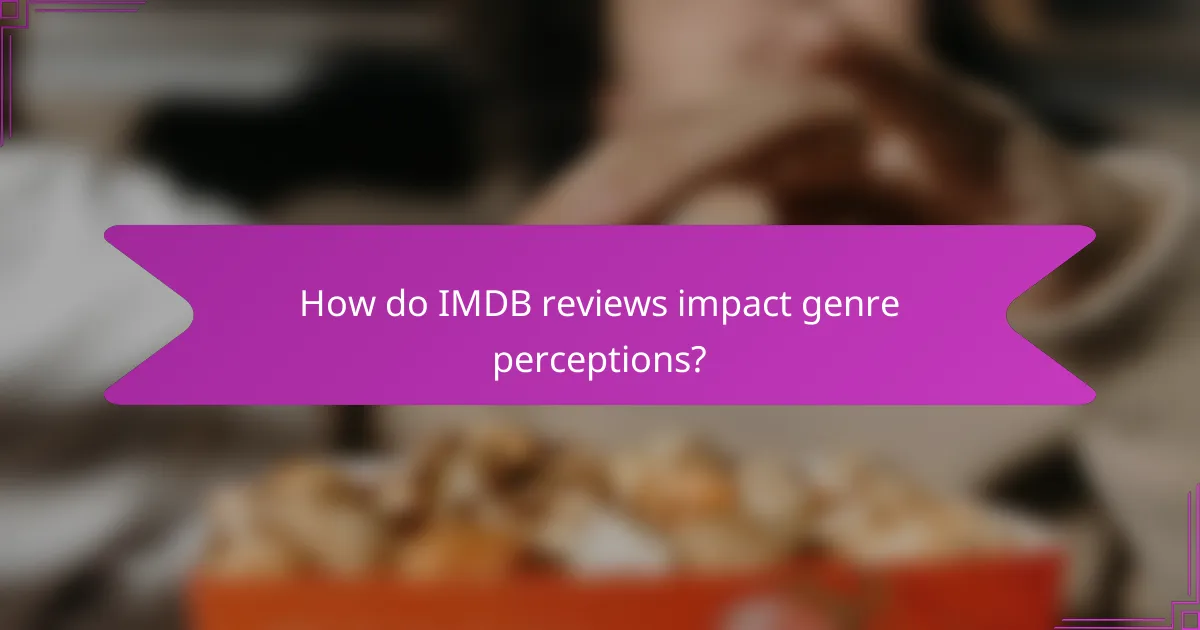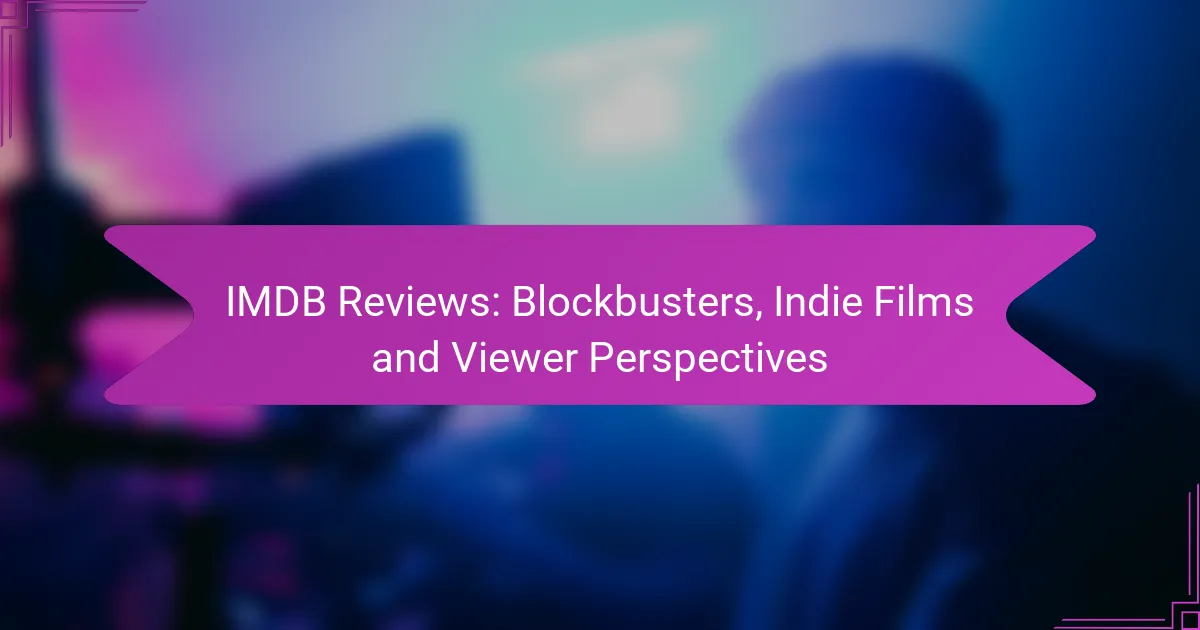IMDB reviews play a crucial role in shaping audience perceptions of film genres, impacting expectations and preferences through collective feedback. By highlighting similarities in themes, character types, and plot structures across genres, these reviews can influence audience engagement and the popularity of specific films. Additionally, demographic factors such as age, gender, and cultural background contribute to the diversity of opinions, ultimately affecting overall ratings and marketing strategies in the film industry.

How do IMDB reviews impact genre perceptions?
IMDB reviews significantly shape how audiences perceive different film genres by influencing their expectations and preferences. Positive or negative feedback can alter the popularity of a genre, as well as affect marketing strategies employed by filmmakers.
Influence on audience expectations
Audience expectations are heavily influenced by IMDB reviews, as viewers often rely on ratings and comments to gauge the quality of a film. A high rating can create anticipation, while a low score may deter potential viewers. For instance, a horror film with a rating above 7.0 is likely to attract more viewers compared to one rated below 5.0.
Moreover, reviews often highlight specific elements like storytelling, acting, or cinematography, which can shape what audiences prioritize when selecting films. This can lead to a more informed viewer base that seeks out particular traits in their preferred genres.
Shaping genre popularity
IMDB reviews can directly impact the popularity of film genres over time. Genres that receive consistent positive feedback tend to gain traction, while those with negative reviews may decline in popularity. For example, the resurgence of interest in superhero films can be attributed to favorable reviews that highlight their engaging narratives and visual effects.
Additionally, trends in reviews can lead to the emergence of sub-genres. As audiences express interest in specific themes or styles, filmmakers may respond by creating more content that aligns with those preferences, further shaping the landscape of genre popularity.
Impact on film marketing strategies
Film marketing strategies are often tailored based on IMDB reviews and ratings. Studios may emphasize positive reviews in promotional materials to attract viewers, using quotes from critics or audience feedback to bolster credibility. For instance, a film with a strong IMDB rating might feature that score prominently in advertisements.
Conversely, if reviews are mixed or negative, marketing campaigns may pivot to focus on star power or unique aspects of the film to draw in audiences. Understanding the sentiment of reviews allows marketers to craft messages that resonate with potential viewers, ultimately influencing box office performance.

What genre similarities are highlighted in IMDB reviews?
IMDB reviews often reveal notable similarities across genres, emphasizing recurring themes, character types, and plot structures. These commonalities can significantly influence audience perception and engagement with films.
Common themes across genres
Many genres share universal themes that resonate with audiences, such as love, betrayal, and redemption. For instance, both romantic comedies and dramas frequently explore the complexities of relationships, albeit through different tones and narratives. Recognizing these themes can enhance viewer appreciation and understanding of a film’s deeper messages.
Additionally, genres like horror and thriller often delve into fear and survival, using suspenseful elements to engage viewers. This thematic overlap allows filmmakers to attract diverse audiences while maintaining a cohesive storytelling approach.
Character archetypes in similar genres
Character archetypes play a crucial role in genre similarities, with certain types appearing across multiple genres. The “hero,” for example, is prevalent in action films, fantasy, and even romantic narratives, often embodying traits like bravery and resilience. This familiarity helps audiences connect with characters quickly.
Moreover, the “mentor” archetype is common in adventure and coming-of-age films, guiding protagonists on their journeys. Understanding these archetypes can provide insights into character development and audience expectations, enhancing the viewing experience.
Plot structures and audience reception
Plot structures often reflect genre conventions, influencing how audiences receive a film. For example, the classic three-act structure is frequently employed in dramas and comedies, providing a familiar framework that audiences find satisfying. This predictability can lead to higher viewer satisfaction when executed well.
Conversely, genres like experimental or art films may deviate from traditional structures, which can polarize audience reception. Filmmakers should be mindful of these expectations, balancing innovation with the need for coherent storytelling to maintain audience engagement.

How do audience demographics affect IMDB reviews?
Audience demographics significantly influence IMDB reviews by shaping how different groups perceive and rate films. Factors such as age, gender, and cultural background can lead to varying preferences and review tendencies, which in turn affect overall ratings.
Age group preferences
Different age groups often have distinct preferences that impact their IMDB reviews. For instance, younger audiences may favor action-packed blockbusters or animated films, while older viewers might lean towards dramas or classic cinema. This divergence can result in varied ratings for the same film based on the predominant age demographic of reviewers.
When analyzing reviews, it’s useful to consider that films appealing to younger viewers might receive higher ratings in the low twenties to low thirties age range, while those targeting older demographics could see ratings skewed towards the mid-forties and above.
Gender differences in ratings
Gender can also play a significant role in how films are rated on IMDB. Studies have shown that male viewers often rate action and sci-fi films higher than female viewers, who may prioritize character development and emotional depth. This can lead to noticeable discrepancies in average ratings for certain genres.
For example, a superhero film might receive a rating of 8.0 from male reviewers but only 6.5 from female reviewers, highlighting the importance of considering gender perspectives when interpreting IMDB ratings.
Cultural influences on review trends
Cultural background can shape how audiences perceive films, leading to different review trends on IMDB. Viewers from different countries may have varying expectations based on cultural norms, which can affect their ratings. For instance, a film that resonates well in the U.S. might not have the same impact in Europe or Asia.
When evaluating reviews, it’s essential to recognize that cultural context can lead to significant differences in ratings. Films that explore universal themes may receive more favorable reviews across diverse cultures, while those with region-specific references might be rated lower by international audiences.

What are the key criteria for analyzing IMDB reviews?
Key criteria for analyzing IMDB reviews include understanding the rating systems, evaluating review length and detail, and conducting sentiment analysis. These factors provide insights into audience perceptions and the overall impact of films.
Rating systems and their implications
The IMDB rating system ranges from 1 to 10, with higher scores indicating better reception. Ratings can significantly influence viewer decisions, as films with scores above 7 often attract more attention. Consider the average rating alongside the number of votes, as a high score from a small audience may not be as reliable as a moderate score from a larger group.
Additionally, the distribution of ratings can reveal trends. For example, a film with a high average but a significant number of low scores may indicate polarized opinions. Understanding these nuances helps in interpreting the overall reception of a film.
Review length and detail
Review length can correlate with the depth of analysis. Short reviews might offer quick impressions, while longer reviews often provide detailed critiques and insights. Aiming for reviews that are at least a few paragraphs long can enhance the understanding of a film’s strengths and weaknesses.
When analyzing reviews, pay attention to the detail provided. Specific examples, character analyses, and plot discussions can indicate a more thoughtful evaluation. Reviews that lack detail may not offer a comprehensive view of the film.
Sentiment analysis of reviews
Sentiment analysis involves assessing the emotional tone of reviews, categorizing them as positive, negative, or neutral. This analysis can reveal overall audience sentiment and highlight common themes in viewer experiences. Tools and algorithms can automate this process, providing quick insights into how a film is perceived.
When conducting sentiment analysis, consider the context of the reviews. A film may receive mixed reviews, with some praising the cinematography while others criticize the plot. Understanding these sentiments can guide potential viewers in making informed choices.

How can filmmakers leverage IMDB reviews for success?
Filmmakers can utilize IMDB reviews to enhance their projects by gaining insights into audience preferences and improving their storytelling. By analyzing feedback, they can refine scripts, target specific viewers, and adjust marketing strategies effectively.
Using feedback for script development
Filmmakers should closely examine IMDB reviews to identify recurring themes and critiques that can inform script development. Positive feedback can highlight what resonates with audiences, while negative comments may reveal weaknesses or areas needing improvement.
For instance, if multiple reviews praise character development but criticize pacing, filmmakers can focus on enhancing the narrative flow while maintaining strong character arcs. This iterative process helps create a more compelling final product.
Targeting specific audience segments
Understanding the demographics of reviewers can help filmmakers tailor their projects to specific audience segments. By analyzing the ratings and comments from different groups, such as age or genre preferences, filmmakers can adjust their content to better meet audience expectations.
For example, if younger viewers express a preference for action and humor in reviews, filmmakers can emphasize these elements in marketing and storytelling to attract that demographic. This targeted approach can lead to higher engagement and box office success.
Improving marketing campaigns based on reviews
IMDB reviews can serve as valuable tools for refining marketing campaigns. Filmmakers can extract key phrases and sentiments from reviews to create promotional materials that resonate with potential viewers. Highlighting positive feedback in trailers or social media posts can build credibility and excitement.
Additionally, filmmakers should monitor ongoing reviews post-release to adapt marketing strategies in real-time. If reviews indicate a strong emotional connection to a specific scene, they can amplify that in advertising efforts to draw in more viewers.

What emerging trends are seen in IMDB reviews?
Emerging trends in IMDB reviews highlight the increasing influence of user-generated content and the evolving preferences of audiences. These trends reflect how viewers engage with films and series, shaping their perceptions and expectations.
Rise of user-generated content
The rise of user-generated content on platforms like IMDB has transformed how audiences interact with films and shows. Users now rely heavily on peer reviews to guide their viewing choices, often valuing these insights over traditional critic reviews.
This trend has led to a more democratic landscape where diverse opinions can flourish. For instance, a film with mixed critical reviews may still achieve high ratings if it resonates with a large audience base, demonstrating the power of collective user feedback.
To navigate this landscape effectively, viewers should consider the volume and sentiment of user reviews. A film with thousands of reviews may provide a more reliable gauge of quality than one with only a handful, as larger datasets tend to smooth out individual biases.



